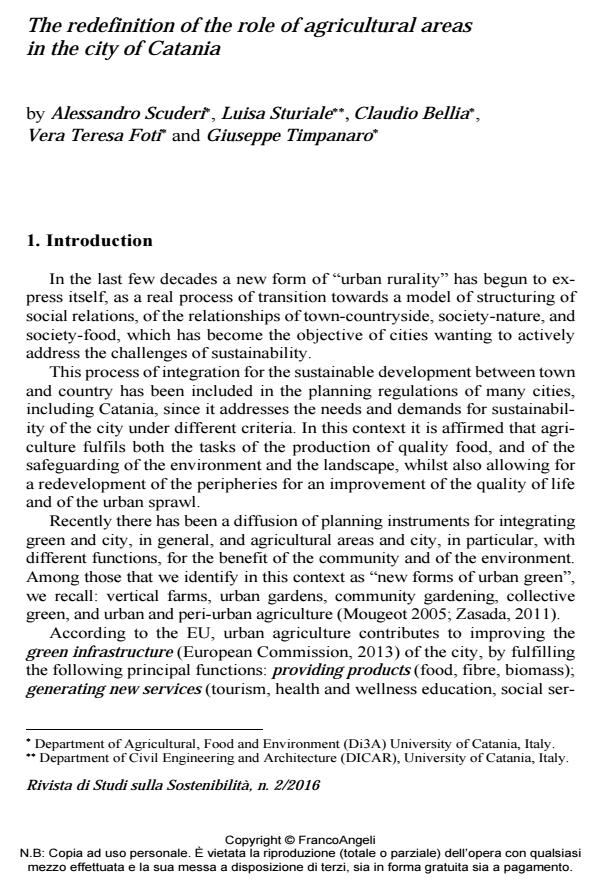The redefinition of the role of agricultural areas in the city of Catania
Titolo Rivista RIVISTA DI STUDI SULLA SOSTENIBILITA'
Autori/Curatori Alessandro Scuderi, Luisa Sturiale, Claudio Bellia, Vera Teresa Foti, Giuseppe Timpanaro
Anno di pubblicazione 2017 Fascicolo 2016/2
Lingua Inglese Numero pagine 11 P. 237-247 Dimensione file 199 KB
DOI 10.3280/RISS2016-002021
Il DOI è il codice a barre della proprietà intellettuale: per saperne di più
clicca qui
Qui sotto puoi vedere in anteprima la prima pagina di questo articolo.
Se questo articolo ti interessa, lo puoi acquistare (e scaricare in formato pdf) seguendo le facili indicazioni per acquistare il download credit. Acquista Download Credits per scaricare questo Articolo in formato PDF

FrancoAngeli è membro della Publishers International Linking Association, Inc (PILA)associazione indipendente e non profit per facilitare (attraverso i servizi tecnologici implementati da CrossRef.org) l’accesso degli studiosi ai contenuti digitali nelle pubblicazioni professionali e scientifiche
In the last few years there seems to have been a growth of interest in green spaces with agricultural activities in the urban environment that have become expressions of a urban agriculture that represent a mode of agricultural exploitation of these green spaces by citizens, able to offer a response to renewed social, alimentary, environmental, and cultural demands. It is in this context that the Municipality of Catania has proposed the creation of one of the largest urban gardens in Europe, in a marginal area of a neighbourhood with a high level of socio-economic degradation of the city. This paper, starting from analysis of urban agriculture at European level, aims, through a SWOT analysis, involving the social and economic partnership in the identification of the highlight the strengths and weaknesses, the opportunities and the threats, of this "new form of urban green", as a valid tool for the integrated development of the territory that encompasses the socio-economic and environmental spheres.
Negli ultimi anni è aumentato l’interesse nei confronti degli spazi verdi con attività agricole in ambiente urbano che sono diventati espressione di un’agricoltura urbana che rappresenta una modalità di valorizzazione agricola di tali spazi a verde cittadini, in grado di offrire risposte a rinnovate esigenze di tipo alimentare, ambientale e socio-culturale. In tale contesto si inserisce la proposta del Comune di Catania di creazione di un orto urbano tra i più vasti d’Europa, in un’area marginale di un quartiere ad elevato degrado socio-economico della città. Il lavoro, partendo dall'analisi dell'agricoltura urbana a livello europeo, si propone, attraverso un’analisi SWOT partecipata, di mettere in evidenzia i punti di forza e di debolezza, le opportunità e le minacce, di questa "nuova forma di verde urbano", quale valido strumento per lo sviluppo integrato del territorio che ricomprende la sfera socio-economico, ambientale.
Parole chiave:Orto urbano, relazione urbano rurale, sviluppo sostenibile, analisi Swot, pianificazione agro-urbana, approccio partecipativo.
- New Metropolitan Perspectives Alessandro Scuderi, Luisa Sturiale, Giuseppe Timpanaro, Gaetano Chinnici, pp.1872 (ISBN:978-3-030-48278-7)
- New food supply chain systems based on a proximity model: the case of an alternative food network in the Catania urban area G. Timpanaro, V.T. Foti, A. Scuderi, G. Schippa, F. Branca, in Acta Horticulturae /2018 pp.213
DOI: 10.17660/ActaHortic.2018.1215.39 - Purchasing behavior in rural areas for food products during the COVID-19 pandemic Gioacchino Pappalardo, Roberta Selvaggi, Michela Pittalà, Claudio Bellia, in Frontiers in Sustainable Food Systems 1042289/2022
DOI: 10.3389/fsufs.2022.1042289
Alessandro Scuderi, Luisa Sturiale, Claudio Bellia, Vera Teresa Foti, Giuseppe Timpanaro, The redefinition of the role of agricultural areas in the city of Catania in "RIVISTA DI STUDI SULLA SOSTENIBILITA'" 2/2016, pp 237-247, DOI: 10.3280/RISS2016-002021